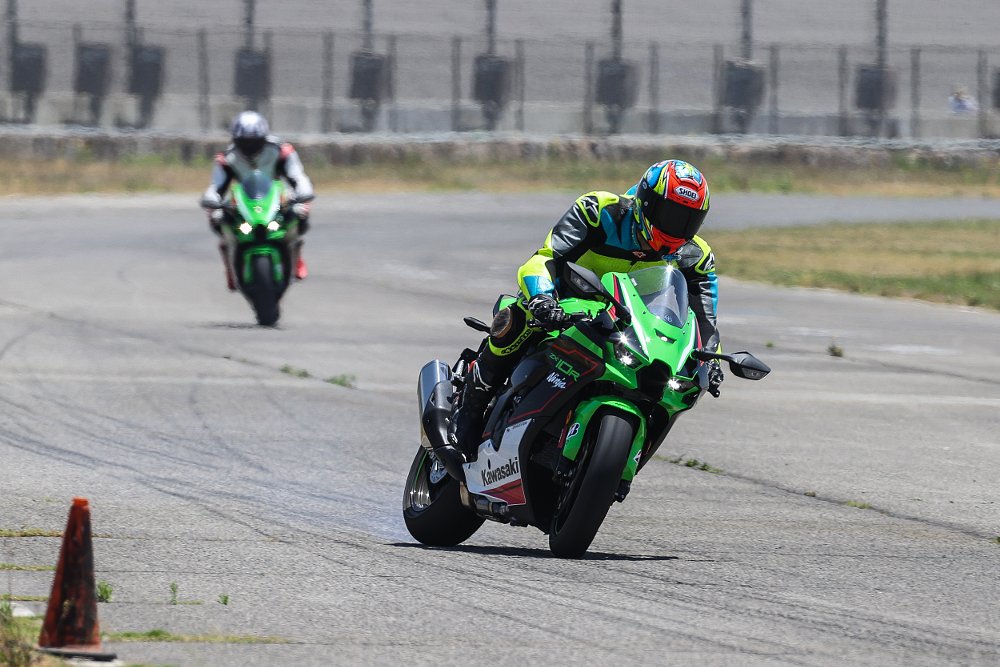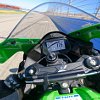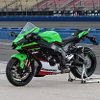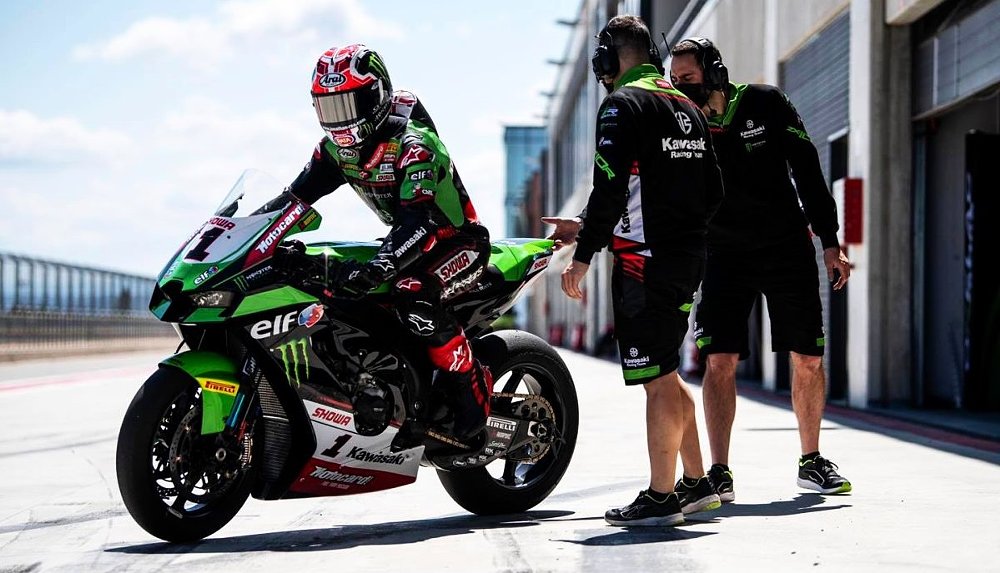Don’t worry about how fast this new Kawasaki ZX-10R is, really. For riders like us, odds are it doesn’t matter.
What’s more important in a showroom superbike these days is making it easier to ride, because that doesn’t just benefit the professionals who race them but also the consumers who buy them, from Sunday riders to wannabe racers and everyone in between. Most of the major brands in this class have focused on improving just that over the past decade, whether it’s the suite of electronics to help tame the couple hundred ponies on tap or mechanical revisions in the chassis.

It depends on the company, but the tagline is usually some version of “exceptional power, ultimate control.” Kawasaki’s mantra, presented alongside the 2021 ZX-10R, is a little more nebulous, encapsulated in one word: Rideology. A pursuit of making sure Kawasaki products “possess both power and gentleness, and are fun and rewarding to control.”
The slower stuff
Whatever it’s called, this new ZX-10R comes with a slew of updates aimed at making the bike more agreeable, on a racetrack and on the street. From a performance standpoint, the engine got a few updates, like a separate-circuit oil cooler, tweaks to the exhaust system, and revised transmission ratios “optimized for circuit riding” by making gears two through six slightly taller and more tightly spaced. Elsewhere, the swingarm pivot moved down by a millimeter, and the last of the cables were removed from the ride-by-wire system. Maybe most notably, the handlebars have moved forward by 10 mm and the footpegs up by five mm.

The other side of the update coin is the stuff arguably designed to keep the street rider happy. A TFT dash now graces the cockpit, with Bluetooth connectivity and a handful of display options. (Spenser did a pretty good job breaking down the mobile app in his first ride of the Z H2, if you’re interested.) In the safety suite, previously the ZX-10 offered adjustment to KTRC (Kawi-speak for traction control) and three power levels for the engine. Now, Sport, Road, and Rain ride modes use preset combinations of those parameters, and up to four programmable Rider modes can be built and accessed in the system. The cherry on top: cruise control.

Beyond that list, there’s some stuff that isn’t obviously for the track or the street. The Showa BFF fork got softer springs and stiffer compression damping for 2021, while the shock received a stiffer spring and softer compression damping. Then there’s the fact that it looks different — a good upgrade for the ZX-10, which was a little long in the tooth from an aesthetic standpoint. The windshield is 40 mm taller, too, and the upper cowl offers more wind protection in general. As a bonus, the new skin includes LED lights and is said to have seven percent less drag, not to mention integrated wings that claim 17 percent more downforce. Because if you don’t have downforce in the superbike class these days, you might as well just go home.

It’s a gaggle of little stuff, plus a new look, that makes the 2021 ZX-10R “new” and it would be easy to take some pot shots at Kawasaki for seemingly phoning in the update. A “longer wheelbase” because the chain adjuster goes back farther? Really? C’mon. Then again, Team Green has won seven of the last nine World Superbike Championships, including six in a row since 2015. So, on second thought, I’ll wait until I have more than 125 WSBK race wins in 10 years to my name before I give anyone at Kawasaki a hard time.

The bike works for Jonathan Rea, no questions there. What’s more important to me, and maybe to you, is how the bike works when I ride it as fast as I can. But, before I gave it the beans I took some time to trundle around Auto Club Speedway in southern California at an approximate street pace. Predictably, this new ZX-10R was perfectly polite below 65 mph, and as usual with a bike like this it sort of felt like using a blender on only the first setting. It hummed along nicely, yawning with boredom, the up/down quickshifter working as smooth as you like. The brakes felt sharp and the TFT dash was crispy and clear.
Of course, in general it’s fairly uncomfortable as a mode of transportation. There’s lots of weight on your wrists and the mirrors are pretty terrible. What the bike clearly wanted to do was accelerate and decelerate really fast over and over again, as evidenced by the 330 mm brake rotors and acres of unused space on the tachometer. And so, after not very much time testing the cruise control and pretending to ride for coffee, I kicked down a few gears and did my darnedest to put the hurt on the Bridgestone slicks.
The faster stuff
The first thing I noticed was the riding position. Previous versions of the ZX-10 felt cramped between the seat and the handlebars for my six-foot, two-inch frame. The slightly more stretched ergos of the 2021 machine immediately worked better for me at speed, moving around in general and under braking, where I could scoot back easily to brace against deceleration more comfortably. On the topic of slowing down, the brakes felt just as sharp at speed as tootling around slowly, and despite the track having a few truly severe braking zones, the system didn’t fade as far as I could tell.

Another thing that makes shedding speed easy on the ZX-10 is the quickshifter, which I found especially good going down through the gears. The auto-blip programming is tuned so well to match revs that I never got so much as a hiccup in the chassis, even when leaned over on the brakes. When it came time to change direction, fast or slow, I kept on being impressed. In 2016 Kawasaki made a bit of noise over an updated crankshaft, which was lighter and therefore allowed the engine to spin up more quickly, as well as reduce reciprocating mass and make the bike easier to flick from side to side. I don’t remember the 2016 machine being a quantum leap but this bike felt totally at home in the midst of the track’s ultra-fast chicane and low-speed direction changes alike.

Most of my performance complaints had to do with acceleration. That’s not to say the ZX-10 is slow, because holy crap it is definitely not that. Right off the bat I found the initial throttle pickup to be abrupt, not so much around the pits but when trying to get back on the gas precisely as I exited a corner. I switched from Full power to Medium (80 percent) and then to Low (60 percent) and found the same slightly harsh hit every time. Throughout the day I adapted to it, but it made me realize that I’m surprised there aren’t alternate maps on the ZX-10R to allow maximum peak power with alternate delivery curves.

Once I was laying power down I found the quickshifter didn’t work quite as well going up as it did going down, predominantly while turning and being hard on the throttle. I gathered that the official word from Kawasaki is that the ECU “prioritizes” traction control and sometimes doesn’t compute the quickshifter request as quickly when KTRC is engaging to limit power. Then there was the top of the rev range, which felt oddly soft to me, and it turns out it wasn't my imagination.
Noise regulations in the United States mean Kawasaki has to trim power and the upper end of the rev limit for North American bikes, meaning peak power comes at 11,500 rpm even though according to the tachometer the engine spins to nearly 14,000 rpm. Kawasaki USA doesn’t claim a peak horsepower number, but the Kawasaki Europe website claims 200 horsepower at 13,200 rpm, which suggests that U.S.-bound ZX-10 models are losing out on nearly 2,000 rpm of revs with the power still climbing. The speedo still showed around 175 mph at the end of the nearly half-mile straightaway — if that’s not fast enough there’s always the accessory ECU, uncorking the rest of the engine’s potential and making the bike illegal for street use.

All the while, as the sessions rolled by, I kept fooling around with KTRC. Levels 4 and 5 are the most conservative and make the bike extremely cautious with power application. Holding the throttle wide open when leaned over in Level 5 resulted in hilariously gentle acceleration; silly on a dry racetrack, sure, but probably great if it’s cold or wet or you accidentally bought too much motorcycle. It’s great that the bike is tunable to that extent.

Feeling oh-so-fast on the race-spec rubber, I spun KTRC down to Level 1 and not long after that let my ambition outweigh my talent, getting a big enough slide out of the rear tire that my feet came off the pegs and my groin landed on top of the gas tank. And with that I learned that KTRC Level 2 was the right mode for me, letting enough power get to the rear tire that it would smear and slide a little without letting me hurt myself.

What I didn’t like was switching between modes on the fly, which takes a long and awkward hold of the “up” or “down” buttons while the throttle is closed. Even though the multiple Rider modes allow a bunch of different combinations of power maps and traction control, the interface doesn’t make them particularly easy to access. This might be minutiae, but when systems exist that allow a quick change of modes or even have paddles to click through levels of TC on the fly, it’s hard not to see the ZX-10R as a little behind the curve. While I’m at it, it’s also a little unsophisticated to have wheelie control and traction control linked in the same system, unable to be adjusted independently.
The bottom line
This is what reviewing a superbike has come to, picking apart tiny slices of the user experience or menu options on a machine that is fully capable of peeling the paint off just about any other vehicle on the road. The thing that crosses my wires is the dichotomy of performance and comfort, and that this bike is somehow reaching for both. We’ve got cruise control, as well as a less comfortable riding position for the street. More stringent emissions technology, and also aerodynamic downforce. Trying to be more of one thing without being less of the opposite is a difficult tug of war.

To my eye, it should be measured as a superbike first and foremost, and I assume Kawasaki feels the same way since it rented a racetrack for us to try the bike. Electronically, I would prefer more of a show of force. There should be a more technical side to the bike. Better to give me too many options and things to adjust than too few. It almost feels like it betrays the ZX-10’s pedigree and success to have such a smooth and capable and impressive machine dulled slightly by cumbersome controls and a simplistic dash. I don’t want to feel like I’m flicking through adjustments on a Z900 or a Ninja 1000, I want a harder edge. Let me into that World Superbike garage with an array of options that speaks to the machine’s capability.
But that’s just about all I’ve got. Mechanically it’s an impressive piece, one that’s more capable than most of the people who will ride it, myself included. It’s a shame its wings are clipped at high revs and I can’t do wheelies with TC on, but the fact is that Kawasaki has evolved the core of the ZX-10R into a better version of itself. As the reasons for these bikes to be more powerful diminish and the case for them to be more user friendly increases, coddling the rider’s ego is the name of the game. And it sure made me feel like I was going fast.
| 2021 Kawasaki Ninja ZX-10R | |
|---|---|
| Price (MSRP) | $16,699 ($17,699 w/ ABS) |
| Engine | 998 cc, liquid-cooled, 16-valve, inline four |
|
Transmission, final drive |
Six-speed, chain |
| Claimed horsepower | na |
| Claimed torque | na |
| Frame | Aluminum twin spar |
| Front suspension | Showa 43 mm BFF fork, adjustable for spring preload, compression and rebound damping; 4.7 inches of travel |
| Rear suspension | Showa monoshock, adjustable for spring preload, compression and rebound damping; 4.5 inches of travel |
| Front brake | Brembo M50 four-piston calipers, 330 mm discs, with ABS |
| Rear brake | Single-piston caliper, 220 mm disc, with ABS |
| Rake, trail | 25 degrees, 4.1 inches |
| Wheelbase | 57.1 inches |
| Seat height | 32.9 inches |
| Fuel capacity | 4.5 gallons |
| Tires | Bridgestone Battlax RS11; 120/70ZR17 front, 190/55ZR17 rear (Bridgestone V02 slicks as tested) |
| Claimed weight | 456.4 pounds (458.6 in California) |
| Available | Now |
| Warranty | 12 months |
| More info | kawasaki.com |


















